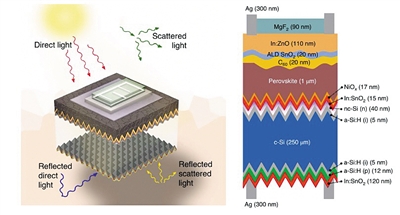Perovskite solar cells are the third-generation solar cells that use perovskite-type organic metal halide semiconductors as light-absorbing materials, which have the characteristics of low costs, high photoelectric conversion efficiency and great commercial potential.
This time the research team analyzed the perovskite band gap required to obtain the best current matching under various real illumination and albedo conditions. The new double-sided tandem solar cell in the study is composed of a silicon layer and a perovskite layer as well as many other compounds. Because a narrow perovskite band gap is used finally, the structure of the device with a transparent back electrode depends on the albedo to enhance the current generated in the bottom cell and the current generated in the perovskite top cell.
The team then reported for the first time that under single-sided AM1.5G sunlight(the reference spectrum of standard testing for the solar energy conversion system), a double-sided tandem device has a certified power conversion efficiency greater than 25%. In an outdoor test field, the power generation density is as high as 26mWcm-2. After comparing the performance of being exposed to different albedo, the research team obtained the diffuse reflection light albedo of the double-sided monolithic perovskite or silicon tandem solar cell in the environment, which is better than single-sided perovskite or silicon tandem solar cells.
The researchers said that the complexity of the tandem device is the main challenge this time. This study involved 14 materials, each of which must be perfectly optimized.
Although conventional series of tandem solar cells can also be converted into electrical energy by absorbing additional wavelengths of light, this time the scientists proved that the use of a double-sided tandem device can exceed the currently recognized performance limit of the tandem device. This new system using the traditional silicon base layer and another layer of perovskite to make a series combination can not only collect more energy, but also capture a lot of light that was originally wasted, reflected and scattered from the ground, which unprecedentedly increases the efficiency of tandem solar cells.

The schematic diagram of a high-efficiency perovskite or silicon double-sided monolithic solar cell based on band gap engineering